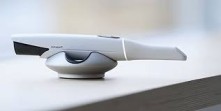Intraoral scanners bring a digital innovation to dentistry industry, offering precision in diagnosing the oral health issues. Earlier, mirrors and alginate impression techniques were used to detect oral health issues in the mouth. One of the significant disadvantages of traditional approach is less accuracy, resulting in incorrect dental impressions. Unlike traditional techniques, intraoral scanners digitally employ imaging sensors, and software algorithms to create precise digital impressions of the teeth, nearby tissues, and oral cavity.
The real-time feedback from the image sensors has completely transformed the dentistry workflow, allowing accurate diagnosis, treatment precision, and making treatment more comfortable for the patients. Owing to their significance, intraoral scanners are currently being used across various dental diagnosis and treatment applications. Let’s explore more about their transformative role in dentistry industry.
Intraoral Scanner: A Revolutionary Technology
It is a digital device that helps to capture high-resolution 3D images of teeth, surrounding tissues, and mouth cavity. Notably, the 3D images data captured by using intraoral scanners allow dentists to diagnose oral issues and adjust treatment to enhance patient comfort. Moreover, it eliminates the requirement for traditional molds to take dental impressions which are uncomfortable and may provide inaccurate results. Digital scanning reduces the chances of error and also allows scanning of complex tissues that are difficult to check with a traditional approach.
In addition to dental impressions, this smart scanning technology streamlines several dental processes, such as dental restoration, treatment of misaligned teeth and the development of dental implants.
Key Features of Intraoral Scanners
Some other promising features are listed below:
- 3D Imaging Capabilities: The real-time 3D imaging capabilities is one of the precious feature of the intraoral scanner. This ability to provide real-time feedback enables dentists to adjust the molds to create accurate dentures. In addition, it can capture multiple images per second and compile up the information into a three-dimensional model of the mouth cavity. The real-time updates not only enhance the speed of diagnosis procedures but also assist in planning treatment with higher accuracy.
- Digital Software Integration: It is essential to note here that the intraoral scanners can easily be integrated with digital software solutions to enhance the overall functionality. This digital integration allows dentists to manipulate the captured images, detailed analyses of the patient’s dental structures, and store and transmit data from anywhere. It also enhances the communication between laboratory personnel and dental clinicians to design a tailored treatment plan for the patients.
Advantages of Integrating Intraoral Scanners
Intraoral scanners offer several advantages that enhance clinician’s ability to provide high-quality dental care and improve patient’s comfort. Several other benefits are listed below:
- High Precision: Intraoral scanners are well known for precision and efficiency. For instance, the 3Shape Tiro series of intraoral scanners has the ability to capture multiple images per second. This ability to capture thousands of images from different angles helps in detailed analysis by creating accurate 3D models of the patient’s oral cavity. The high precision of intraoral scanners is essential to create well-fitted dental restorations and dental implants, eliminating the requirement for readjustment and re-analysis of data.
- Reduced Time and Improved Workflow: Intraoral scanners can be integrated with digital software which further eliminates the time required to ship dental models physically and reduces potential errors. The ability to capture images and transmit them to the dental laboratories in no time accelerates the dental treatment process, streamline clinical workflows and reduce burden from clinicians.
- Improved Treatment Outcomes: The high accurate image data provided by the intraoral scanners can lead to better treatment outcomes. Moreover, these scanners also reduce the issues associated with patient treatment, such as improper fitting of dentures, inaccurate impressions and requirement for multiple models. Additionally, the real-time data scans help dental practitioners to make an informed decisions.
Key Applications of Intraoral Scanners in Dentistry
Some more applications of intraoral scanners are listed below:
- Prosthodontics: Intraoral scanners are also widely used for the designing of dental crowns, veneers, bridges, and dentures with higher precision. This capability to capture multiple images helps to analyze occlusal contours which enhances the fitting of prosthetic devices. It eliminates the requirement for prosthetic device adjustment and redesigning.
- Oral Surgery: Intraoral scanners can also play a significant role in oral surgery planning. These scanners help to analyze complex surgical intrusions which further assist in creating surgical guides for implant placement with higher precision.
Future Scope of Intraoral Scanners
Looking forward, the intraoral scanner industry experts aim to enhance scanning technology. The future focus will be on improving image quality, contrasting characteristics, and integrating artificial intelligence to analyze data with precision. In addition, the industry players will also focus on the improvement of software algorithms to enhance the accuracy of scanners. The focus on dental treatment accuracy will further encourage industry players to stay at the forefront of technological innovations to fully leverage the intraoral scanning capabilities.
